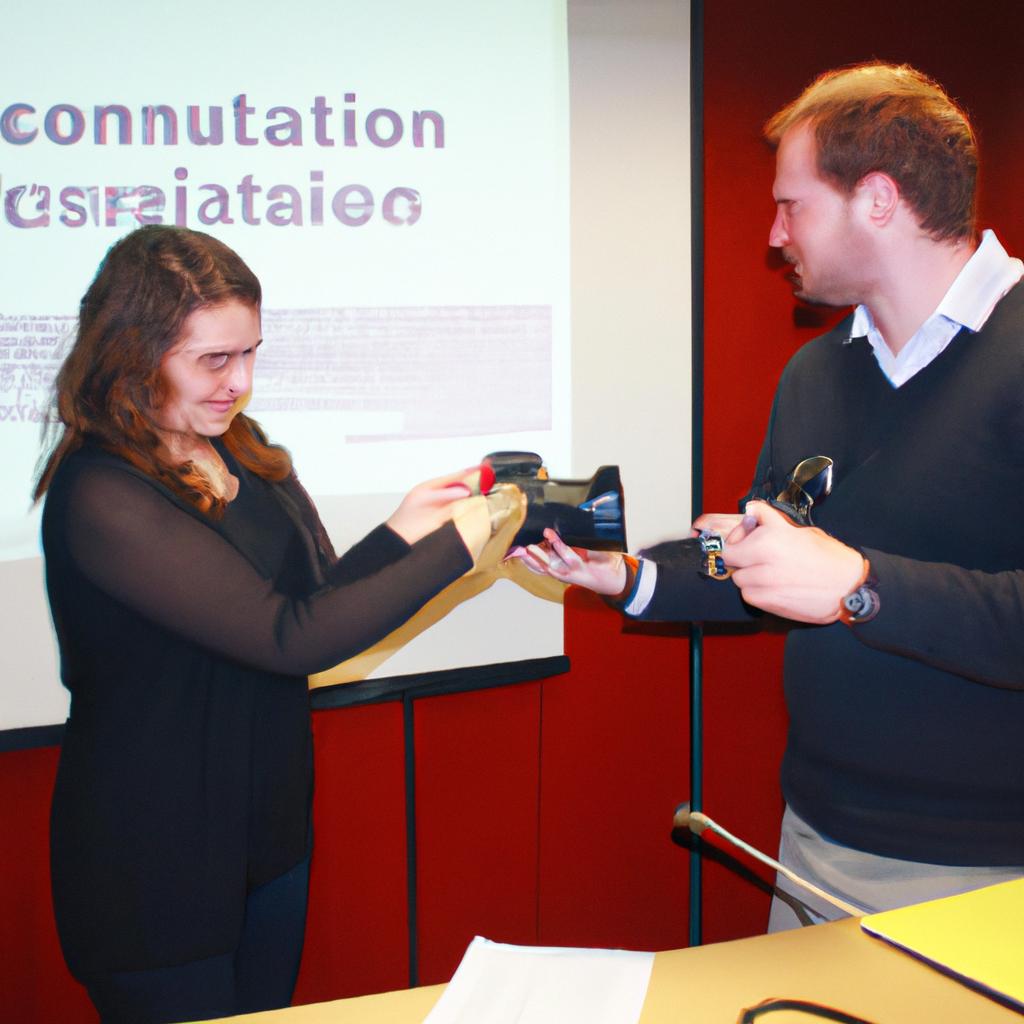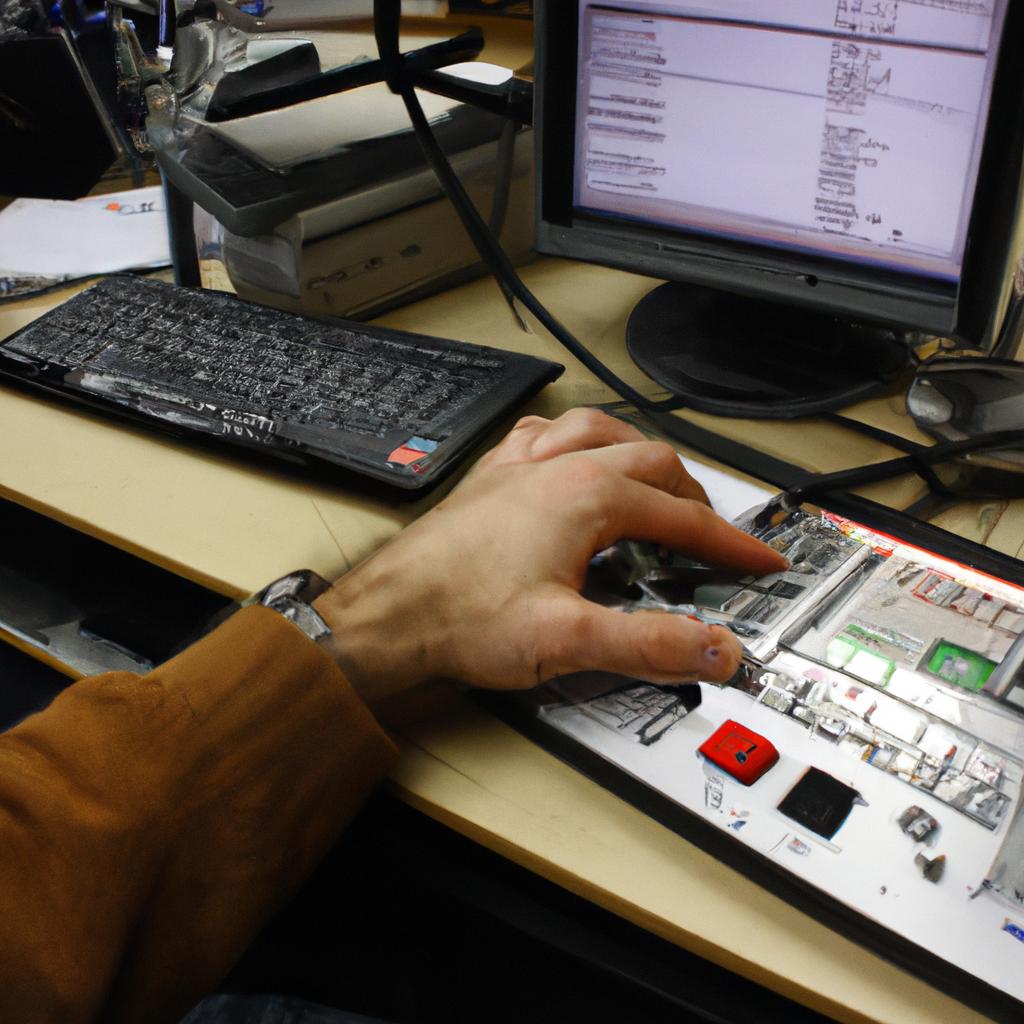Over the past few decades, radio broadcasting has undergone significant advancements. One of these notable developments is the emergence of HD Radio technology, which offers superior audio quality and additional features compared to traditional analog broadcasts. Within this realm, RDS (Radio Data System) plays a crucial role in enhancing the overall listening experience for audiences. For instance, imagine tuning into your favorite radio station on an HD Radio receiver and being able to see real-time information about the song currently playing, such as its title and artist name. This article aims to explore the concept of RDS in HD Radio, examining its benefits, functionalities, and impact on both broadcasters and listeners.
RDS serves as a communication protocol that enables digital data transmission alongside FM or AM radio signals. By embedding supplementary information within these signals, RDS enhances user experiences by delivering a range of useful content beyond just audio programming. For example, it allows stations to transmit text-based messages containing traffic updates, weather forecasts, news headlines, and even emergency alerts directly to receivers equipped with RDS capabilities. Consequently, listeners can stay informed without relying solely on visual media sources or interrupting their regular listening habits.
Furthermore, RDS provides valuable opportunities for broadcasters to engage with their audience through interactive features. Listeners using compatible receivers can participate in polls, contests, and surveys initiated by the radio station. They can also receive personalized messages or notifications based on their preferences or location. This level of interactivity not only enhances the listener experience but also allows broadcasters to gather valuable data about their audience’s preferences and behaviors.
In addition to interactive features, RDS offers practical benefits for listeners. For instance, it enables automatic tuning to alternative frequencies when a station’s signal becomes weak or unstable, ensuring uninterrupted listening even during long drives or in areas with varying reception quality. RDS also facilitates easy identification and selection of stations by displaying their names on the receiver’s screen instead of relying solely on frequency numbers.
For broadcasters, RDS provides a platform for branding and promotion. By transmitting their station name, logo, and other information through RDS signals, they can effectively reinforce their identity in the minds of listeners. Moreover, RDS allows broadcasters to display dynamic content like advertisements or event promotions that can be targeted specifically to certain geographic locations or time slots.
Overall, the adoption of RDS in HD Radio technology has revolutionized radio broadcasting by offering an enhanced listening experience and increased engagement opportunities for both broadcasters and audiences alike. With its ability to transmit supplementary information alongside audio signals, RDS has transformed radio into a multi-dimensional medium that goes beyond traditional analog broadcasts. As technology continues to evolve, we can expect further advancements in RDS functionality and its integration with other digital platforms to continue shaping the future of radio broadcasting.
What is RDS?
What is RDS?
RDS, or Radio Data System, is a technology that allows FM radio stations to transmit additional information alongside their regular audio broadcasts. This system was first introduced in Europe in the late 1980s and has since become widely adopted around the world. One example of how RDS enhances the listening experience is through its ability to display song titles and artist names on compatible receivers, making it easier for listeners to identify the music being played.
To understand the benefits of RDS, let’s consider four key advantages this technology offers:
- Enhanced Information: RDS provides a platform for broadcasters to share various types of data with listeners. In addition to displaying song metadata, it can also deliver traffic updates, weather forecasts, news headlines, and emergency alerts.
- Improved Navigation: With RDS-enabled receivers, drivers can access navigation prompts directly from their car radios. This feature eliminates the need for separate GPS devices or smartphone apps while driving.
- Dynamic Content Displays: By utilizing scrolling text features embedded within RDS signals, broadcasters can relay longer messages without interrupting the audio stream. These displays can include advertisements, concert announcements, or public service announcements.
- Seamless Integration: RDS seamlessly integrates into existing FM broadcast infrastructure without requiring significant changes or investments. It operates within the same frequency band as traditional analog radio transmissions.
In summary, RDS enriches the FM radio experience by providing supplementary information and services beyond just audio content. Its versatility enables broadcasters to engage with audiences more effectively while enhancing convenience and safety for listeners.
Transitioning into discussing “How does RDS work in HD Radio?”, we will explore further details about this technology’s implementation and capabilities
How does RDS work in HD Radio?
RDS in HD Radio: How it Enhances Broadcasting Experience
Imagine driving down the highway, listening to your favorite radio station. Suddenly, a traffic alert interrupts the music and informs you about an accident ahead, allowing you to choose an alternate route and avoid getting stuck in a long delay. This seamless integration of real-time information with traditional FM or AM broadcasting is made possible by RDS (Radio Data System) technology in HD Radio.
One key aspect of RDS is its ability to transmit data alongside audio content. With RDS-enabled receivers, listeners can access additional information such as song titles, artist names, and even upcoming events or advertisements related to the current broadcast. This enhances the overall listening experience by providing valuable context and engaging the audience beyond just audio content.
To better understand how RDS works in HD Radio, let’s explore three main features that contribute to its effectiveness:
-
Traffic Information: As mentioned earlier, RDS allows broadcasters to deliver live traffic updates directly to compatible receivers. By utilizing this feature, drivers can stay informed about road conditions and make informed decisions regarding their commute. For instance, during heavy congestion or accidents, real-time traffic alerts can be displayed on receiver screens or announced audibly, enabling motorists to navigate more efficiently.
-
Emergency Alerts: In times of emergencies or severe weather events, RDS becomes crucial for disseminating critical information quickly. Public safety agencies can utilize this system to broadcast emergency alerts across multiple stations simultaneously. Whether it’s a tornado warning or an Amber Alert for a missing child, RDS ensures that important messages reach a wide audience promptly.
-
Enhanced Content Services: Besides traffic and emergency alerts, RDS enables broadcasters to offer enhanced services like interactive advertising campaigns tailored to specific regions or demographics. Advertisements can include clickable URLs embedded within text displays on receiver screens or voice prompts guiding listeners towards online promotions or discounts.
To further highlight the advantages of incorporating RDS into HD Radio, consider the following table:
| Benefits of RDS in HD Radio |
|---|
| Improved road safety by providing real-time traffic updates. |
| Enhanced emergency communication during crises or severe weather events. |
| Interactive advertising campaigns that engage and target specific audiences. |
| Seamless integration of additional content like song titles and artist information with traditional broadcasting. |
In summary, RDS technology plays a vital role in enhancing the broadcasting experience in HD Radio. By delivering real-time information such as traffic updates, emergency alerts, and interactive content services, it keeps listeners engaged and informed throughout their journey.
Next Section: ‘Benefits of RDS in HD Radio’
Benefits of RDS in HD Radio
RDS in HD Radio: Benefits and Implementation
In the previous section, we discussed how RDS (Radio Data System) works in HD Radio. Now let’s delve into the benefits of incorporating RDS technology in HD Radio systems.
Imagine you are driving through a city and listening to your favorite radio station on an HD Radio receiver equipped with RDS. Suddenly, the traffic report comes on, providing real-time updates about road conditions and accidents along your route, allowing you to make informed decisions and potentially avoid delays or hazards. This is just one example of how RDS enhances the user experience in HD Radio.
The implementation of RDS in HD Radio brings several advantages for broadcasters and listeners alike:
- Enhanced content: With RDS, stations can transmit additional information alongside their audio broadcasts, such as song titles, artist names, program schedules, news headlines, weather forecasts, and even advertising messages.
- Improved navigation: By utilizing the Traffic Message Channel (TMC) feature of RDS, drivers can receive up-to-date traffic information directly on their car radios. This helps them plan alternative routes or anticipate delays more effectively.
- Increased audience engagement: The availability of supplementary data via RDS encourages listener interaction. For instance, call-in contests or surveys can be conducted where participants respond using the interactive capabilities of their HD Radio receivers.
- Advertising opportunities: RDS enables targeted advertising by allowing stations to transmit specific messages based on factors like geographic location or demographic profiles. Advertisers benefit from reaching a more relevant audience while maximizing their return on investment.
To illustrate these benefits further, consider the following table showcasing potential uses for RDS in various broadcasting scenarios:
| Scenario | Potential Use |
|---|---|
| Music radio station | Displaying song title and artist |
| News radio station | Transmitting news headlines |
| Weather forecast service | Sharing current weather conditions |
| Traffic radio station | Broadcasting real-time traffic info |
In conclusion, the integration of RDS into HD Radio systems offers a range of benefits such as enriched content, improved navigation, increased audience engagement, and targeted advertising opportunities. These advantages enhance the overall listening experience and provide valuable information to listeners in real time.
Implementing RDS in HD Radio receivers opens up even more possibilities for broadcasters to deliver engaging content while providing users with an intuitive interface and access to supplementary data.
Implementing RDS in HD Radio receivers
Benefits of RDS in HD Radio Receivers
Building upon the discussion of the benefits of RDS in HD Radio, let us now explore how these advantages can be implemented effectively. To illustrate this, consider a hypothetical scenario where a popular radio station decides to upgrade its broadcasting system to include RDS capabilities. This decision is motivated by the desire to enhance the listening experience for their audience and provide them with additional information related to the songs being played.
Implementing RDS in HD Radio receivers involves several key steps:
- Integration: The first step is to ensure that the existing infrastructure supports RDS technology. This may require upgrading broadcast equipment or investing in new hardware that is compatible with both HD Radio and RDS standards.
- Data Encoding: Once the integration is complete, the next step is encoding relevant data into RDS format. This includes metadata such as song titles, artist names, album details, and even advertising messages.
- Transmission: The encoded data is then transmitted alongside the audio signal through a subcarrier frequency within the FM band. It should be noted that this transmission does not interfere with existing analog signals and remains compatible with traditional FM radios.
- Receiver Compatibility: Lastly, it is essential to ensure that HD Radio receivers are capable of decoding and displaying the received RDS data accurately. Improvements in receiver design have made it possible to present this information on screen displays or via mobile applications connected to the receiver.
- Enhanced User Experience
- Increased Engagement
- Accessible Information
- Improved Advertising Opportunities
Furthermore, here is a three-column table highlighting some potential benefits of utilizing RDS technology:
| Benefit | Implementation | Impact |
|---|---|---|
| Song Title Display | Encoded Metadata | Easy Song Identification |
| Traffic Updates | Real-Time Information | Efficient Commuting |
| Emergency Alerts | Dedicated RDS Channel | Enhanced Safety |
| Advertising Opportunities | Targeted Messaging | Increased Revenue |
In conclusion, implementing RDS in HD Radio receivers enables broadcasters to deliver additional information and services, enhancing the overall listening experience for audiences. This integration requires careful consideration of infrastructure compatibility, data encoding, transmission methods, and receiver design. Next, let us delve into the fascinating realm of RDS data transmission in HD Radio without missing a beat.
Next section: ‘RDS Data Transmission in HD Radio’
RDS data transmission in HD Radio
Implementing RDS in HD Radio receivers allows for the transmission of additional information alongside audio content, enhancing the listening experience. One example of this implementation is a car radio that displays real-time traffic updates using RDS data. This feature provides drivers with valuable information and helps them make informed decisions about their routes.
To understand how RDS enhances HD Radio receivers, consider the following benefits:
- Improved user experience: With RDS, listeners can access station identification, song titles, artist names, and other relevant information directly on their receiver’s display. This feature not only adds convenience but also enables users to discover new music or easily navigate between stations.
- Enhanced emergency alerts: RDS supports the broadcasting of emergency messages such as weather warnings or public safety announcements. These alerts are crucial in situations where immediate action needs to be taken by individuals within the broadcast range.
- Interactive services: Some broadcasters utilize RDS capabilities to offer interactive services like voting polls or text-based competitions. Listeners can actively participate through their HD Radio receivers, engaging with their favorite stations and creating a sense of community.
In addition to these advantages, incorporating RDS in HD Radio has led to advancements in data transmission methods. For instance, the use of subcarrier technology enables seamless integration of RDS into existing HD Radio infrastructure without significant disruptions.
The table below summarizes some key features and benefits of implementing RDS in HD Radio receivers:
| Feature | Benefit |
|---|---|
| Real-time traffic | Enables drivers to make informed routing decisions |
| Emergency alerts | Enhances public safety communication |
| Interactive services | Promotes listener engagement and involvement |
| Seamless integration | Minimizes disruption when integrating with existing systems |
These benefits demonstrate why incorporating RDS into HD Radio receivers is an important development in broadcasting technology. In conclusion, this section has explored how implementing RDS improves user experiences and offers various functionalities beyond standard audio transmission. The next section will delve into future developments for RDS in HD Radio, highlighting the potential advancements and possibilities that lie ahead.
Future developments for RDS in HD Radio
RDS data transmission in HD Radio has paved the way for improved broadcasting capabilities, allowing radio stations to provide enhanced information and services to their listeners. Building upon this foundation, future developments for RDS in HD Radio hold promise for further advancements in the realm of digital radio.
One potential area of growth is the integration of RDS with other emerging technologies such as internet connectivity and mobile applications. For instance, imagine a scenario where an individual is driving in their car listening to an HD Radio station that utilizes RDS. Through the combination of RDS and internet connectivity, the listener could receive real-time traffic updates on their vehicle’s navigation system or even interact with social media platforms seamlessly. This integration would not only enhance the user experience but also increase engagement and convenience.
- Improved accessibility: Listeners can access additional content related to what they are currently hearing on a specific radio station.
- Enhanced interactivity: Users can actively participate by voting in polls or contests through their connected devices.
- Personalized experiences: RDS technology can allow users to customize their preferences based on location, language, genre, etc.
- Real-time information: Traffic updates, weather forecasts, news alerts, and emergency notifications can be delivered instantly.
Furthermore, future developments may involve expanding the capabilities of RDS beyond traditional audio broadcasting. An example of this expansion could be incorporating visual elements into radio transmissions using hybrid systems like Visual Radio. By combining audio with synchronized graphics or images displayed on compatible receivers or mobile devices, broadcasters have the opportunity to offer a more immersive and engaging experience for listeners.
To showcase some potential features enabled by Visual Radio within HD Radio equipped vehicles:
| Feature | Description | Benefit |
|---|---|---|
| Album artwork display | View album covers corresponding to songs being played | Enhances aesthetic appeal and enhances music discovery |
| Artist information display | Access artist biographies, discographies, and related media | Provides listeners with additional context and background |
| Advertisements | Display visual advertisements relevant to the listener | Increases advertising effectiveness while minimizing clutter |
| Event notifications | Promote upcoming concerts or events visually | Encourages attendance and engagement |
In conclusion, future developments for RDS in HD Radio hold immense potential for revolutionizing the radio listening experience. The integration of RDS with internet connectivity, mobile applications, and hybrid systems like Visual Radio can offer improved accessibility, enhanced interactivity, personalized experiences, real-time information updates, as well as audio-visual synergy. As advancements continue to unfold, it is exciting to envision how these technologies will shape the future of radio broadcasting.
 K7BUC
K7BUC



